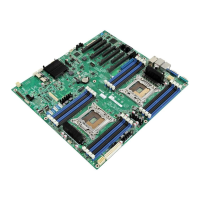
Do you have a question about the Intel S2600CO Family and is the answer not in the manual?
| Product Type | Server Board |
|---|---|
| Chipset | Intel C602 |
| Memory Type | DDR3 |
| Maximum Memory Supported | 512 GB |
| Integrated Graphics | No |
| CPU Socket Type | LGA 2011 |
| Processor Support | Intel Xeon E5-2600 series processors |
| Memory Slots | 16 |
| Management | IPMI 2.0 |
| Power Connectors | 1 x 24-pin |
| Power Supply | ATX |
| Form Factor | SSI EEB (12" x 13") |
| SATA | 6 x SATA 3Gb/s, 2 x SATA 6Gb/s |
| RAID Support | Intel Rapid Storage Technology enterprise (RSTe) (0, 1, 10, 5) |
Provides an overview of the document's chapter structure and contents.
Legal notice regarding server board usage, airflow, and operating limits.
Identification and description of key connectors and components on the server board.
Diagrams showing the physical dimensions and mounting hole locations of the server board.
Details on supported Intel Xeon processors, including TDP and population rules.
Overview of processor features like QPI, IMC, and IIO subsystems.
Description of the Intel C600-A chipset's features and functions.
Details on the integrated BMC features and its hardware components.
Explanation of Intel TXT for security and protection against software attacks.
Overview of Intel VT-x, VT-d, and VT-c for virtualization capabilities.
Features for managing power consumption and thermal characteristics in data centers.
Configuration and management of BIOS administrator and user passwords.
Details on TPM hardware security for boot process integrity and data protection.
Features supported by the integrated BMC firmware, including IPMI 2.0.
Support for various ACPI power states (S0, S1, S5) for system power management.
Identification of sources that can initiate power-up or power-down activities.
Functionality of the BMC watchdog for automatic system recovery and fault detection.
BIOS and BMC algorithms for booting the system even if the bootstrap processor fails.
BMC's role in monitoring system hardware health via sensors.
Interface for accessing and managing FRU inventory information.
BMC implementation of the system event log for storing system events.
BMC control and monitoring of system fans for cooling and acoustics.
Supported communication interfaces for BMC, including IPMB, LAN, and KCS.
Remote access to keyboard, video, and mouse via web server as a Java applet.
Enables mounting remote IDE or USB devices as server-attached media.
Description of main power and CPU power connectors on the server board.
Details on connectors for front panel features like power button and LEDs.
Connectors for SATA/SAS storage devices and RAID upgrade keys.
Connectors for RMM4 Lite, TPM, PMBUS, and Chassis Intrusion.
Procedure for clearing CMOS settings and resetting BIOS passwords using jumpers.
Procedure for forcing BMC firmware update when standard method fails.
Procedure for forcing ME firmware update when standard method fails.
Procedure to boot recovery BIOS and flash normal BIOS using a jumper.
Location and function of the 5V standby LED indicating AC power presence.
LEDs indicating fan faults for CPU and system fans.
LEDs indicating memory errors for each DIMM socket.
LEDs for system identification, status, and POST code reporting.
Guidelines for matching processor TDP with server board capabilities.
Calculated Mean Time Between Failures (MTBF) estimates.
Minimum and maximum ratings for power supply output voltages and currents.